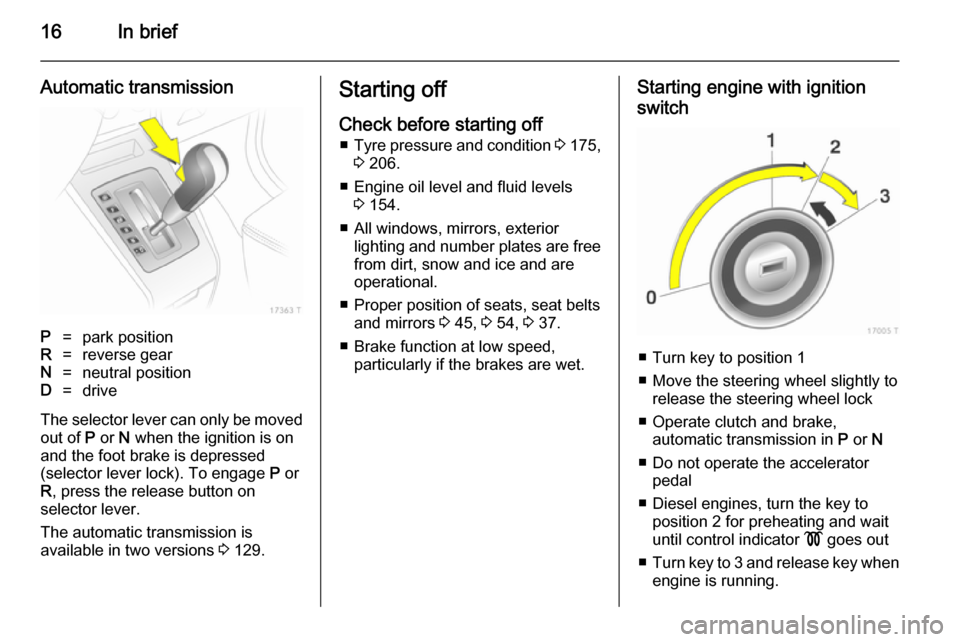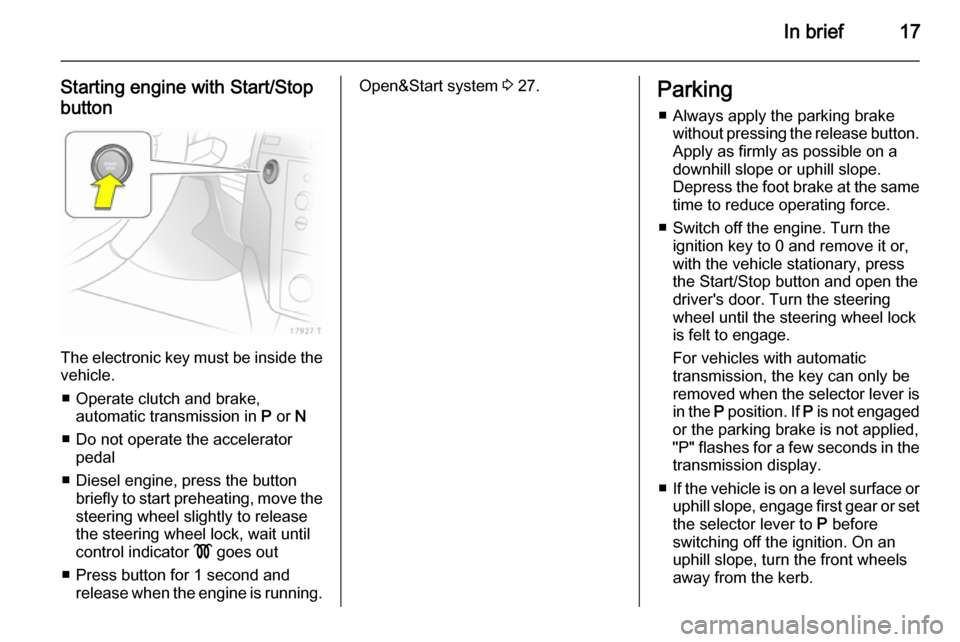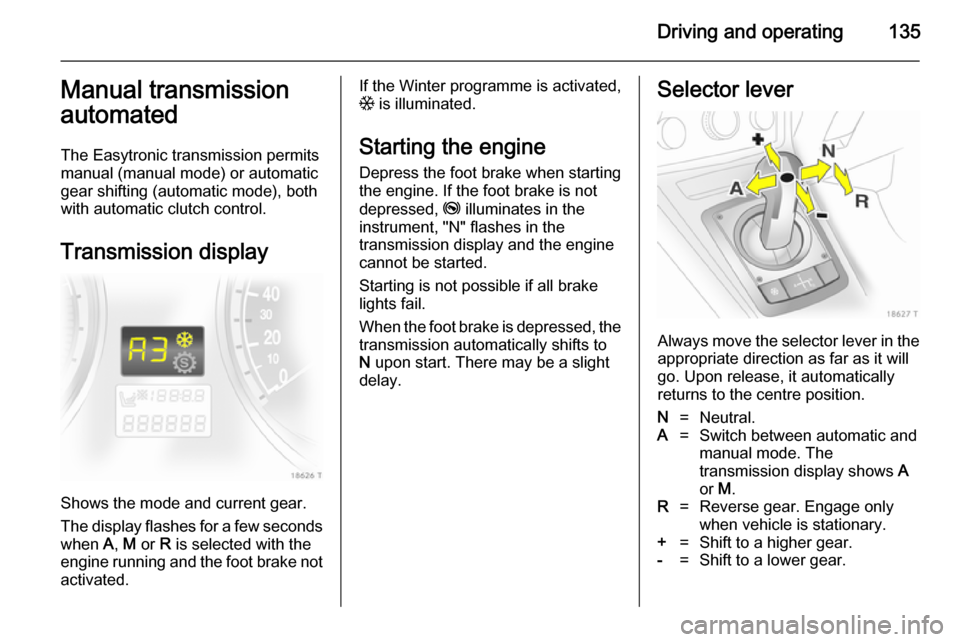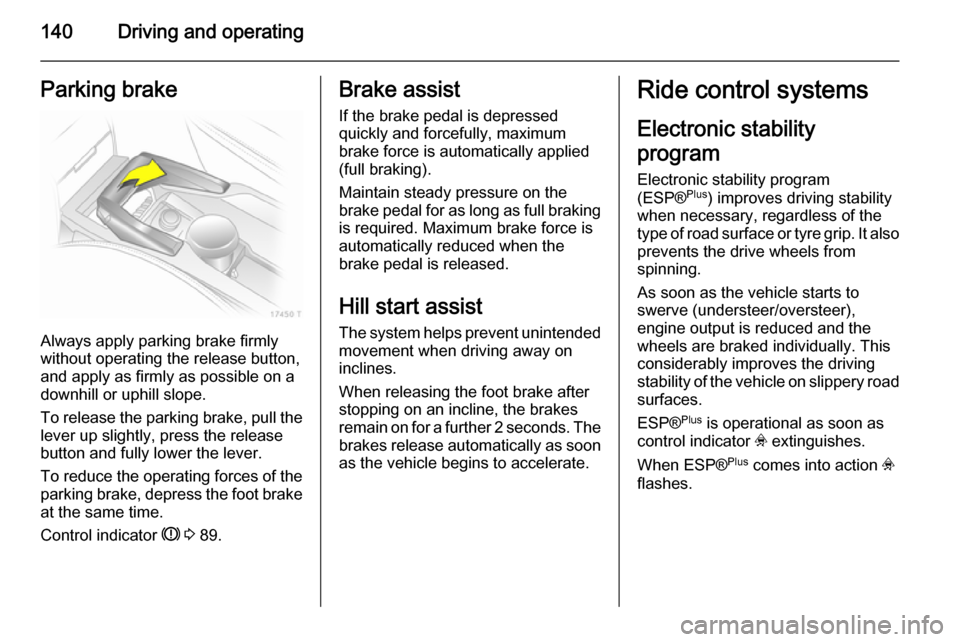brake light VAUXHALL ZAFIRA 2014.5 Owner's Manual
[x] Cancel search | Manufacturer: VAUXHALL, Model Year: 2014.5, Model line: ZAFIRA, Model: VAUXHALL ZAFIRA 2014.5Pages: 219, PDF Size: 7.83 MB
Page 13 of 219

In brief11
1Light switch ........................ 109
Instrument illumination .......114
Rear fog light ....................... 113
Front fog lights ...................112
Headlight range
adjustment ......................... 110
2 Side air vents ...................... 123
3 Turn and lane-change
signals, headlight flash,
low beam and high beam ...112
Exit lighting .......................... 115
Parking lights ...................... 113
Cruise control ....................... 93
4 Steering wheel controls ........78
5 Horn ...................................... 79
Driver airbag ......................... 60
6 Instruments .......................... 84
7 Windscreen wiper,
windscreen washer
system, headlight washer
system .................................. 79
8 Centre air vents ................... 1239Left heated seat ....................48
Tyre pressure monitoring
system ................................. 176
Ultrasonic parking assist ......90
Hazard warning flashers .....112
Central locking system ..........30
Sport mode ........................... 90
Right heated seat ..................48
10 Info-Display ........................... 94
Trip computer ...................... 103
Electronic climate control
system ................................. 120
11 Front passenger airbag .........60
12 Glovebox .............................. 68
13 Infotainment system ..............10
14 Climate control system ........ 117
15 Selector lever, manual
transmission ....................... 134
Manual transmission
automated ........................... 135
Automatic transmission .......12916Ashtray .................................. 83
17 Start/Stop button .................. 27
18 Accelerator pedal ................125
19 Ignition switch with
steering wheel lock .............126
Sensor panel for
emergency operation of
Open&Start system ..............27
20 Brake pedal ......................... 139
21 Clutch pedal ........................ 125
22 Steering wheel adjustment ...78
23 Bonnet release lever ...........154
Page 18 of 219

16In brief
Automatic transmissionP=park positionR=reverse gearN=neutral positionD=drive
The selector lever can only be movedout of P or N when the ignition is on
and the foot brake is depressed
(selector lever lock). To engage P or
R , press the release button on
selector lever.
The automatic transmission is
available in two versions 3 129.
Starting off
Check before starting off ■ Tyre pressure and condition 3 175,
3 206.
■ Engine oil level and fluid levels 3 154.
■ All windows, mirrors, exterior lighting and number plates are free
from dirt, snow and ice and are
operational.
■ Proper position of seats, seat belts and mirrors 3 45, 3 54, 3 37.
■ Brake function at low speed, particularly if the brakes are wet.Starting engine with ignition
switch
■ Turn key to position 1
■ Move the steering wheel slightly to release the steering wheel lock
■ Operate clutch and brake, automatic transmission in P or N
■ Do not operate the accelerator pedal
■ Diesel engines, turn the key to position 2 for preheating and wait
until control indicator ! goes out
■ Turn key to 3 and release key when
engine is running.
Page 19 of 219

In brief17
Starting engine with Start/Stop
button
The electronic key must be inside the
vehicle.
■ Operate clutch and brake, automatic transmission in P or N
■ Do not operate the accelerator pedal
■ Diesel engine, press the button briefly to start preheating, move thesteering wheel slightly to release
the steering wheel lock, wait until
control indicator ! goes out
■ Press button for 1 second and release when the engine is running.
Open&Start system 3 27.Parking
■ Always apply the parking brake without pressing the release button.Apply as firmly as possible on a
downhill slope or uphill slope.
Depress the foot brake at the same
time to reduce operating force.
■ Switch off the engine. Turn the ignition key to 0 and remove it or,
with the vehicle stationary, press
the Start/Stop button and open the
driver's door. Turn the steering
wheel until the steering wheel lock
is felt to engage.
For vehicles with automatic
transmission, the key can only be
removed when the selector lever is in the P position. If P is not engaged
or the parking brake is not applied,
"P" flashes for a few seconds in the transmission display.
■ If the vehicle is on a level surface or
uphill slope, engage first gear or set the selector lever to P before
switching off the ignition. On an
uphill slope, turn the front wheels
away from the kerb.
Page 90 of 219

88Instruments and controlsTurn signal
O illuminates or flashes green.
Illuminates The control indicator illuminates
briefly when the parking lights are
switched on. Parking lights 3 113.
Flashes
The control indicator flashes if a turn
signal or the hazard warning flashers
are activated.
Rapid flashing: failure of a direction
indicator lamp or associated fuse,
failure of direction indicator lamp on
trailer.
Bulb replacement 3 159. Fuses
3 166.
Turn signals 3 112.
Seat belt reminder X illuminates or flashes red.
Illuminates
After the ignition is switched on until
the seat belt is fastened.Flashes
After starting off until the seat belt is
fastened.
Fastening the seat belt 3 54.
Airbag and belt tensioners v illuminates red.
When the ignition is switched on, the
control indicator illuminates for
approx. 4 seconds. If it does not
illuminate, does not go out after
4 seconds or illuminates whilst
driving, there is a fault in the belt
tensioner or the airbag system. The
systems may fail to trigger in the event of an accident.
Deployment of the belt tensioners or
airbags is indicated by continuous
illumination of v.9 Warning
Have the cause of the fault
remedied immediately by a
workshop.
Airbag system, belt tensioners 3 57,
3 53.
Charging system p illuminates red.
Illuminates when the ignition is
switched on and goes out shortly after
the engine starts.
Illuminates when the engine isrunning
Stop, switch off engine. Battery is not charging. Engine cooling may be
interrupted. In diesel engines, power
to the brake servo unit may be cut.
Seek the assistance of a workshop.
Malfunction indicator light Z illuminates or flashes yellow.
Illuminates when the ignition is
switched on and goes out shortly after
the engine starts.
Page 94 of 219

92Instruments and controls
1. Depress clutch.
2. Select neutral gear, set selector lever to N.
3. Move out of the flow of traffic as quickly as possible without
impeding other vehicles.
4. Switch off ignition.9 Warning
When the engine is off,
considerably more force is needed
to brake and steer.
Do not remove key until vehicle is stationary, otherwise the steeringwheel lock could engage
unexpectedly.
Check oil level before seeking the
assistance of a workshop 3 154.
Low engine oil level
S illuminates yellow.
Engine oil level is checked
automatically.
Illuminates when the engine is
running
Low engine oil level. Check engine oil
level and top up as necessary
3 154.
Low fuel Y illuminates or flashes yellow.
Illuminates Level in fuel tank too low.
Flashes
Fuel used up. Refuel immediately.
Never run the tank dry.
Catalytic converter 3 129.
Bleeding the diesel fuel system
3 158.
Open&Start system
0 illuminates or flashes yellow.
Flashes The electronic key is no more within
the reception range of the vehicle interior. The engine cannot bestarted. Hold the Start/Stop button
depressed a bit longer to switch off
the ignition.
or
Failure of the electronic key.
Operation is yet only possible via
emergency operation.
Illuminates
Fault in system. Try to operate with
the spare key, the remote control or
through emergency operation. Hold
the Start/Stop button depressed a bit
longer to switch off the ignition. Seek the assistance of a workshop.
or
The steering wheel lock is still
engaged. Move the steering wheel
slightly and press the Start/Stop
button.
Open&Start system 3 27.
Apply footbrake
j illuminates yellow.
Page 95 of 219

Instruments and controls93
The engine with manual transmission
automated can only be started if the
foot brake is depressed. If the foot
brake is not depressed, the control
indicator illuminates 3 135.
Exterior light 8 illuminates green.
Illuminates when the exterior lights
are on 3 109.
High beam C illuminates blue.
Illuminates when high beam is on and
during headlamp flash 3 110.
Adaptive forward lighting
B illuminates or flashes yellow.
Illuminates
Fault in system.
If the swivelling device for curve
lighting fails, the corresponding low
beam lamp is deactivated and the fog lamp is switched on.Seek the assistance of a workshop.
Flashes System switched to symmetrical low
beam.
Control indicator B flashes for
approx. 4 seconds after the ignition is
switched on as a reminder that the
system has been switched 3 110.
Adaptive Forward Lighting (AFL)
3 111.
Fog light
> illuminates green.
Illuminates when the front fog lights
are on 3 112.
Rear fog light
r illuminates yellow.
Illuminates when the rear fog light is
on 3 113.
Cruise control
m illuminates green.Illuminates when the system is on
3 142.
Door open
Q illuminates red.
Illuminates when a door or the tailgate
is open.
Page 103 of 219

Instruments and controls101Vehicle messages
Messages are given via the
instrument panel display or as
warning and signal buzzers. Check
control messages appear on the
Info-Display. Some appear in an
abbreviated form. Confirm warning
messages with the multifunction knob
3 94, 3 97.
Warning chimes When starting the engine or
whilst driving ■ If the electronic key is not present or is not recognised.
■ If seat belt is not fastened.
■ If a door or the tailgate is not fully closed when starting off.
■ If a certain speed is exceeded with the parking brake applied.
■ If the speed programmed at the factory is exceeded.
■ If the vehicle has automated manual transmission and the
driver's door is opened when theengine is running, a gear is
engaged and the foot brake is not
depressed.
When the vehicle is parked and
the driver's door is opened ■ When the key is in the ignition switch.
■ With exterior lights on.
■ With Open&Start system and automatic transmission, if the
selector lever is not in P.
■ For automated manual transmission, if the parking brake is
not applied and no gear is engaged when the engine is switched off.
Battery voltage
Low battery voltage in radio remote
control or electronic key. On vehicles
without check control, the message
InSP3 appears in the instrument
panel display. Replace the battery
3 26, 3 27.Brake light switch
Brake light does not come on during
braking. Have the cause of the fault
remedied immediately by a
workshop.
Engine cooling level
Low fluid level in engine cooling
system. Check coolant level 3 155.
Page 128 of 219

126Driving and operatingIgnition switch positions0=Ignition off1=Steering wheel lock released,ignition off2=Ignition on, for diesel engine:
preheating3=StartingStarting the engine
Starting engine with ignition
switch
Operate clutch and brake, automatic
transmission in P or N.
Do not operate accelerator pedal.
Diesel engines: turn the key to
position 2 for preheating until control
indicator ! goes out.
Turn key briefly to position 3 and
release key when engine is running.
Before restarting or to switch off the engine, turn key back to 0.
Starting engine with the
Start/Stop button
The electronic key must be inside the
vehicle. Operate clutch and brake,
automatic transmission in P or N.
Do not operate accelerator pedal.
Diesel engines: press the button
briefly to start preheating, move the
steering wheel slightly to release the
steering wheel lock, wait until control
indicator ! goes out and then press
button for 1 second and release when
the engine is running.
Page 137 of 219

Driving and operating135Manual transmission
automated
The Easytronic transmission permits manual (manual mode) or automatic
gear shifting (automatic mode), both
with automatic clutch control.
Transmission display
Shows the mode and current gear.
The display flashes for a few seconds
when A, M or R is selected with the
engine running and the foot brake not
activated.
If the Winter programme is activated,
T is illuminated.
Starting the engine
Depress the foot brake when starting
the engine. If the foot brake is not
depressed, j illuminates in the
instrument, "N" flashes in the
transmission display and the engine
cannot be started.
Starting is not possible if all brake
lights fail.
When the foot brake is depressed, the
transmission automatically shifts to
N upon start. There may be a slight
delay.Selector lever
Always move the selector lever in the
appropriate direction as far as it will
go. Upon release, it automatically
returns to the centre position.
N=Neutral.A=Switch between automatic and
manual mode. The
transmission display shows A
or M.R=Reverse gear. Engage only
when vehicle is stationary.+=Shift to a higher gear.-=Shift to a lower gear.
Page 142 of 219

140Driving and operatingParking brake
Always apply parking brake firmly
without operating the release button,
and apply as firmly as possible on a
downhill or uphill slope.
To release the parking brake, pull the lever up slightly, press the release
button and fully lower the lever.
To reduce the operating forces of the
parking brake, depress the foot brake
at the same time.
Control indicator R 3 89.
Brake assist
If the brake pedal is depressed
quickly and forcefully, maximum
brake force is automatically applied
(full braking).
Maintain steady pressure on the
brake pedal for as long as full braking
is required. Maximum brake force is
automatically reduced when the
brake pedal is released.
Hill start assist
The system helps prevent unintended movement when driving away on
inclines.
When releasing the foot brake after
stopping on an incline, the brakes
remain on for a further 2 seconds. The brakes release automatically as soon
as the vehicle begins to accelerate.Ride control systems
Electronic stability
program
Electronic stability program
(ESP® Plus
) improves driving stability
when necessary, regardless of the
type of road surface or tyre grip. It also
prevents the drive wheels from
spinning.
As soon as the vehicle starts to
swerve (understeer/oversteer),
engine output is reduced and the
wheels are braked individually. This
considerably improves the driving
stability of the vehicle on slippery road
surfaces.
ESP® Plus
is operational as soon as
control indicator v extinguishes.
When ESP® Plus
comes into action v
flashes.